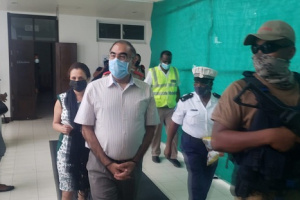Nature Seychelles is tagging fish to find their migratory movements
(Seychelles News Agency) - The Rabbit fish found in Seychelles waters, can swim fantastic distances. This was one of the findings of Tove Jörgensen, Danish fish researcher for environmental conservation organisation Nature Seychelles.
"A Rabbit fish leaves Cousin Island and swims 3 km during the full moon to a spawning site," Tove says as she starts doing her maths.
"It weighs an average of 300 grams, so it’s the equivalent of a normal-sized human swimming 600 km. That's pretty far; it's one third of the distance from the Seychelles to Tanzania!" she jokes.
Jörgensen is looking at information she has gathered under a Nature Seychelles' project that is investigating the habitats and migratory movements of commercially valuable fish species within and outside the Cousin Island Marine Protected Area (MPA).
Fish spawning areas around Cousin, fish movement between the MPA and fished areas, and the connectivity between the MPA and nearby fish spawning aggregations are under study.
The Government of Seychelles-GEF-UNDP funded project is being carried out in collaboration with the Seychelles Fishing Authority (SFA) and local fishermen.

| The researcher on Cousin Island, Tove Jörgensen. She was born in Denmark and grew up in Sweden, studied biology at Stockholm University and decided to become a marine biologist after scuba diving in Thailand on a holiday. Tove did her master thesis in the northern Philippines on small community-based marine reserve and worked for the Seychelles Fishing Authority in the Seychelles on grouper spawning aggregations. She lived in Queensland in Australia and studied at James Cook University in Townsville and started her PhD “Understanding ecological links in marine coastal areas”, which include field work on how climate change affects high latitude corals in Vietnam and fish migration in Tanzania. (Nature Seychelles) Photo license: Attribution |
The tags, which are secured to the outside of fish, contain a unique number identifying the individual fish as well as contact information of Nature Seychelles. This kind of tagging is dependent on the fish being recaptured to recover the tag.
This way information on where the fish was tagged and where it was picked up can be recorded.Jörgensen and her team have collected members of the target fish species within the Cousin Island MPA, and tagged and released them to track their range of movement during spawning.

| Laying transects on a spawning site (Tove Jörgensen, Nature Seychelles) Photo license: Attribution |
Tove says the tags deployed on the fish inside the MPA are now getting back to her, thanks to the help of fishers in Praslin, the second largest islands of the Seychelles archipelago, who get rewarded for every tag they return.
"The tags have a telephone number, so the fishermen call us or just drop them off. This is not a new concept - the SFA has already done similar work with fishers in Praslin so it's familiar to them and they are keen to help," she says.
"We have gotten to know the fishermen quite well and they've seen us at the spawning sites in our little boat," she adds.
Thanks to the returned tags, she also knows when and where the fish are spawning and the kind of habitats they like.
"A couple of days before the spawning, we see the fish gathering at a point of the MPA we call the bus station. They then start moving and are not seen again until they are at the spawning sites," she says.
Apart from the conventional tags, Tove will also be deploying acoustic tags, which send out sound and allow remote tracking of fish as they move.
"SFA already have their listening stations at the different spawning sites and I have them inside the MPA. So the next step is to deploy the tags into the fish inside the MPA," she says.
Liz Mwambui works for Nature Seychelles, and writes regularly for Seychelles newspapers.






